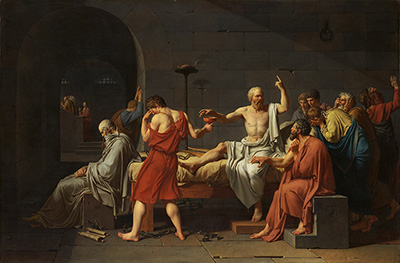Jacques Louis David painted many painting from myth and legend, including fables from ancient Greece, as well as many scenarios that were – or, at least, were believed to be – real.
While absolute belief in Biblical stories has now faded considerably, there are still some ancient tales that are believed to be rooted in the real. One such narrative is that of Socrates's death. Socrates was a philosopher and teacher who left no written wisdom of his own: we only know of him at all through the writings of his contemporaries and his students who all but revered his wisdom and his humility. However, it was these traits that were his downfall too: Socrates knew that he knew very little on the scale of what their was to know, which, according to the Oracle, made him wiser than all the other statesmen, experts and teachers who felt that they were very wise indeed.
Apply this notion to the entire state, and it will soon be seen how Socrates's clear-eyed observations and calling out of foolishness on the part of the state would have first irked and then outraged the government of the time. It was his admiration for the state of Sparta, though, that really provoked fury, with his fellow citizens seeing this as a kind of treason.
Put on trial, the judges asked for Socrates's own wisdom as regards his sentence. Wittily he replied that he should be given a wage and free meals for the rest of his life for keeping Athens honest. Needless to say, this kind offer was declined, and he was sentenced to death through drinking a mixture of hemlock and other unnamed substances. Socrates had the opportunity to escape, and declined to: he felt it would show a lack of honour and a fear of death which true philosophers, he said, did not have. He also felt that to spend his life elsewhere, would simply mean a repeat of his questioning of the status quo, with possibly similar results.
This is the story that David depicts in The Death of Socrates. While David chose to include characters who were not at the deathbed and removed many who were, the image is compelling. Socrates has just drained the poison and handed the vessel back to a young man who is distraught: as are many of those around the bed. Plato, from whom history learned the story of Socrates's death in the first place is seated at the end of the bed, calm but despondent at the impending death while Crito, Socrates's friend, clutches the dying philosopher's thigh in an agony of denial.
The scene is dramatic, the colour conveying the brutality of the act and the emotion of those around the deathbed, while Socrates, dressed loosely in white, seems already to have loosened his hold on the material world, gesturing upwards, as though sure of a welcome in heaven. The oil on canvas painting is immense, measuring almost 1.3m by just under 2m. It can be found in the Metropolitan Museum of Art in New York City.




